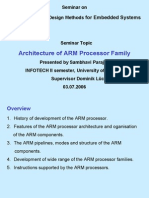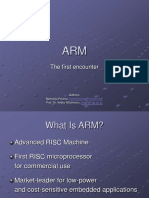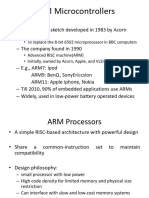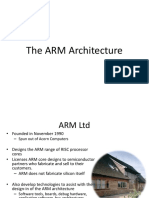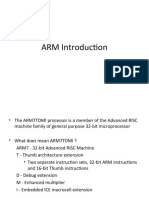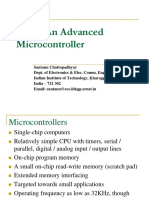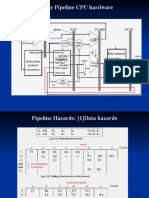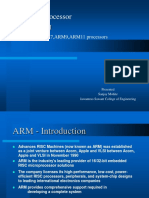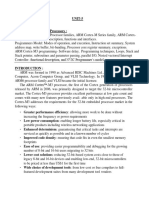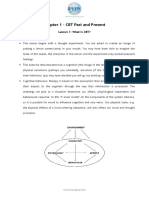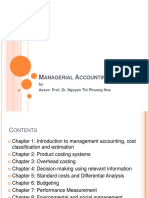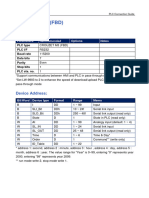ARM Architecture Overview
Development of the ARM Architecture
Processor Architecture = Instruction Set + Programmers model
4T
ARM7TDMI ARM922T Thumb instruction set
5TE
ARM926EJ- S ARM946E-S ARM966E-S Improved ARM/Thumb Interworking DSP instructions Extensions: Jazelle (5TEJ)
6
ARM1136JF -S ARM1176JZF-S ARM11 MPCore SIMD Instructions Unaligned data support Extensions: Thumb-2 (6T2) TrustZone (6Z) Multicore (6K) Thumb-2 Extensions:
7
Cortex-A8/R4/M3/M1
v7A (applications) NEON v7R (real time) HW Divide V7M (microcontroller) HW Divide and Thumb-2 only
Note: Implementations of the same architecture can be very different
ARM7TDMI - architecture v4T. Von Neuman core with 3 stage pipeline ARM920T - architecture v4T. Harvard core with 5 stage pipeline and MMU
2
�ARM Architecture profiles
Application profile (ARMv7-A e.g. Cortex-A8)
Memory management support (MMU) Highest performance at low power Influenced by multi-tasking OS system requirements TrustZone and Jazelle-RCT for a safe, extensible system
Real-time profile (ARMv7-R e.g. Cortex-R4)
Protected memory (MPU) Low latency and predictability real-time needs Evolutionary path for traditional embedded business
Microcontroller profile (ARMv7-M e.g. Cortex-M3)
Lowest gate count entry point Deterministic and predictable behavior a key priority Deeply embedded use
3
Programmers Model
�Data Sizes and Instruction Sets
When used in relation to the ARM:
Halfword means 16 bits (two bytes) Word means 32 bits (four bytes) Doubleword means 64 bits (eight bytes)
Most ARMs implement two instruction sets
32-bit ARM Instruction Set 16-bit Thumb Instruction Set Provides a mixture of 32-bit and 16-bit instructions Maintains code density with increased flexibility
Latest ARM cores introduce a new instruction set Thumb-2
Jazelle-DBX cores can also execute Java bytecode
Processor Modes
The ARM has seven basic operating modes:
Each mode has access to own stack and a different subset of registers Some operations can only be carried out in a privileged mode
Mode Supervisor (SVC) FIQ IRQ Abort Undef System User Description Entered on reset and when a Software Interrupt instruction (SWI) is executed Entered when a high priority (fast) interrupt is raised Entered when a low priority (normal) interrupt is raised Used to handle memory access violations Used to handle undefined instructions Privileged mode using the same registers as User mode Mode under which most Applications / OS tasks run Unprivileged mode Privileged modes
Exception modes
�The ARM Register Set
User mode
r0 r1 r2 r3 r4 r5 r6 r7 r8 r9 r10 r11 r12 r13 (sp) r14 (lr) r15 (pc) cpsr spsr Current mode spsr spsr spsr spsr
IRQ
FIQ
Undef
Abort
SVC
ARM has 37 registers, all 32-bits long A subset of these registers is accessible in each mode
r13 (sp) r14 (lr)
r8 r9 r10 r11 r12 r13 (sp) r14 (lr)
r13 (sp) r14 (lr)
r13 (sp) r14 (lr)
r13 (sp) r14 (lr)
Banked out registers
Program Status Registers
31 28 27 24 23 19 16 15 10 9 8 7 6 5 4 0
N Z C V Q de f
n s
d e f GE[3:0]
IT n e d i cond_abc x
E A
I F T c
mode
Condition code flags
N = Negative result from ALU Z = Zero result from ALU C = ALU operation Carried out V = ALU operation oVerflowed Sticky Overflow flag - Q flag Architecture 5TE and later only Indicates if saturation has occurred J bit Architecture 5TEJ and later only J = 1: Processor in Jazelle state Interrupt Disable bits I = 1: Disables IRQ F = 1: Disables FIQ
T Bit
T = 0: Processor in ARM state T = 1: Processor in Thumb state Introduced in Architecture 4T Mode bits Specify the processor mode New bits in V6
GE[3:0] used by some SIMD instructions E bit controls load/store endianness A bit disables imprecise data aborts IT [abcde] IF THEN conditional execution of Thumb2 instruction groups
8
�Data alignment
Prior to architecture v6 data accesses must be appropriately aligned for access size
Unaligned addresses will produce unexpected/undefined results
Byte access (byte aligned)
3 7 b f 2 6 a e 1 5 9 d 0 4 8 c
Halfword access (halfword aligned)
2 6 a e 0 4 8 c
Word access (word aligned)
0 4 8 c
Unaligned data can be accessed using multiple aligned accesses combined with shift/mask operations
Exception Handling
When an exception occurs, the core:
Copies CPSR into SPSR_<mode> Sets appropriate CPSR bits Change to ARM state Change to exception mode Disable interrupts (if appropriate) Stores the return address in LR_<mode> Sets PC to vector address
0x1C 0x18 0x14 0x10 0x0C 0x08 0x04
FIQ IRQ (Reserved) Data Abort Prefetch Abort
Software Interrupt Undefined Instruction
To return, exception handler needs to:
0x00
Reset
Restore CPSR from SPSR_<mode> Restore PC from LR_<mode>
Vector Table
Vector table can also be at
0xFFFF0000 on most cores
Must be done in ARM state in most cores, but... ...Thumb-2 capable cores can do this in Thumb state
10
�Introduction to Instruction Sets
11
ARM Instruction Set
All instructions are 32 bits long / many execute in a single cycle Instructions are conditionally executed A load / store architecture
Example data processing instructions SUB r0,r1,#5 ADD r2,r3,r3,LSL #2 ADDEQ r5,r5,r6 Example branching instruction B <Label> Example memory access instructions LDR r0,[r1] STRNEB r2,[r3,r4] STMFD sp!,{r4-r8,lr}
r0 = r1 - 5 r2 = r3 + (r3 * 4) IF EQ condition true r5 = r5 + r6
Branch forwards or backwards relative to current PC (+/- 32MB range)
Load word at address r1 into r0 IF NE condition true, store bottom byte of r2 to address r3+r4 Store registers r4 to r8 and lr on stack. Then update stack pointer
12
�Thumb Instruction Set
Thumb is a 16-bit instruction set
Optimized for code density from C code (~65% of ARM code size) Improved performance from narrow memory Subset of the functionality of the ARM instruction set
Thumb is not a regular instruction set!
Constraints are not generally consistent Targeted at compiler generation, not hand coding
13
Thumb-2 Instruction Set
Thumb-2 is a major extension to the Thumb ISA
Adds 32-bit instructions to implement almost all of the ARM ISA functionality Retains the complete 16-bit Thumb instruction set
Design objective: ARM performance with Thumb code density
No switching between ARM-Thumb states Compiler automatically selects mix of 16 and 32 bit instructions
14
�Thumb 2 Performance / Density
100% ARM code
Performance
Thumb-2
Random mix
Profiled mix
100% Thumb code
Code density
15
Processor Cores
16
�ARM7TDMI Processor
Architecture v4T 3-stage pipeline Single interface to memory
17
ARM926EJ-S Processor
ARM926EJ-S
Architecture v5TE 5-stage pipeline Single-cycle 32x16 multiplier Caches and TCMs Memory management unit (MMU) 2 AHB memory interfaces Jazelle technology
18
�ARM1176JZ(F)-S Processor Core
TrustZone 8-stage pipeline Branch prediction Four AXI memory ports IEM (Intelligent Energy Management) Integrated VFP coprocessor
19
ARM11 MPCore Processor
MP11
MP11
MP11
MP11
1 4 MP11 processors Cache coherency Distributed interrupt controller
20
�ARM Cortex-M3 Processor
Architecture v7-M (Thumb-2 only) Very different from previous ARM processors No CPSR register Vector table contains addresses, not
instructions
Processor automatically saves/restores
state in exceptions
Only 2 processor modes (Thread/Handler) No Coprocessor 15 3-stage pipeline with
static branch prediction
Atypical Implementation Fixed memory map Integrated interrupt controller Serial-Wire Debug
21
ARM Cortex-A8 Processor
Architecture v7-A 14 stage pipeline NEON media processor
22
�The Instruction Pipeline
23
The Instruction Pipeline
The ARM7TDMI uses a 3-stage pipeline in order to increase the speed of the flow of instructions to the processor
Allows several operations to be performed simultaneously, rather than serially
ARM PC Thumb PC
FETCH
Instruction fetched from memory
PC - 4
PC-2
DECODE
Decoding of registers used in instruction Register(s) read from Register Bank Shift and ALU operation Write register(s) back to Register Bank
PC - 8
PC - 4
EXECUTE
The PC points to the instruction being fetched, not executed
Debug tools will hide this from you This is now part of the ARM Architecture and applies to all processors
24
�Optimal Pipelining
Cycle Operation ADD SUB ORR AND ORR EOR F D F E D F E D F E D F M E D F E D E W 1 2 3 4 5 6 7 8 9
F - Fetch
D - Decode
E - Execute
All operations here are on registers (single cycle execution) In this example it takes 6 clock cycles to execute 6 instructions Clock cycles per Instruction (CPI) = 1
25
Branch Pipeline Example
Cycle Address 0x8000 0x8004 0x8008 0x8FEC 0x8FF0 0x8FF4 Operation BL 0x8FEC SUB ORR AND ORR EOR F D F E D F F D F M E D F E D E W EL EA 1 2 3 4 5 6 7 8 9
F - Fetch
D - Decode
E Execute L Linkret
A - Adjust
Breaking the pipeline Note that the core is executing in ARM state
26
�Cortex-A8 Integer Pipeline
Branch Mispredict Penalty Replay Penalty F0 F1 F2 D0 D1
DEC SEQ DEC DEC Score Regfile board Queue & Issue Remap Logic Reg File Shift ALU SAT BP Update ADD WB ALU MUL PIPE0
D2
D3
D4
E0
E1
E2
E3
E4
E5
AGU
RAM TLB Branch Pred.
Queue
Early DEC Early DEC
Route
MUL1
MUL2
WB
Instruction Fetch
Pending Replay Queue
Shift
ALU
SAT
BP Update
WB
ALU PIPE1
Instruction Decode
AGU RAM + Format BP TLB Fwd Update WB LOAD STORE
Instruction Execute / Load Store
Optimising code to make use of the processor pipeline is very difficult Leave it to the compiler!!
27
Reference Slides
28
�Reference Material
ARM ARM (Architecture Reference Manual)
ARM DDI 0100E covers v5TE DSP extensions Can be purchased from booksellers - ISBN 0-201-737191 (Addison-Wesley) Available for download from ARMs website ARM v7-M ARM available for download from ARMs website Contact ARM if you need a different version (v6, v7-AR, etc.)
Steve Furber ARM system-on-chip architecture - 2nd edition
ISBN 0-201-67519-6 (Addison-Wesley)
Sloss, Symes & Wright ARM System Developer's Guide
ISBN: 1-55860-874-5 (Morgan Kaufman)
RVCT Assembler Guide
Available for download from ARMs website
Technical Reference Manuals for processor core being used
Available for download from ARMs website
29
Naming Conventions
ARMx1z (e.g. ARM710T) indicates cache & full MMU ARMx2z (e.g. ARM720T) indicates cache, MMU & Process ID support ARMx3z (e.g. ARM1136J-S) indicates physically mapped caches and MMU ARMx4z (e.g. ARM740T) indicates cache and MPU ARMx5z (e.g. ARM1156T2-S) indicates cache, MPU and error correcting memory ARMx6z (e.g. ARM966E-S) indicates write buffer but no caches ARMx7z (e.g. ARM1176JZ-S) indicates AXI bus, & physically mapped caches and MMU ARMxy6 (e.g. ARM946E-S) indicates TCMs
30
�Which architecture is my processor?
Processor core Architecture
v4T v4T v5TE, v5TEJ v5TE, v5TEJ v6
v6 v6T2 v6Z v6 v7-A v7-R v7-M v6-M
ARM7TDMI family
ARM720T, ARM740T ARM920T,ARM922T,ARM940T ARM946E-S, ARM966E-S, ARM926EJ -S
ARM9TDMI family ARM9E family ARM10E family
ARM1020E, ARM1022E, ARM1026EJ -S
ARM11 family
ARM1136J(F)-S ARM1156T2(F)-S ARM1176JZ(F)-S ARM11 MPCore ARM Cortex -A8 ARM Cortex -R4(F) ARM Cortex -M3 ARM Cortex -M1
Cortex family
For ARM processor naming conventions and features, please see the Appendix
31
ARMv4T Cores:
7TDMI
Architecture Cache Associativity TCM Replacement Write Strategy Write Buffer MMU/MPU Hi Vectors Streaming Standby Mode
von Neumann None N/A No N/A N/A None None No N/A No
720T
von Neumann 8K Unified 4 words/line 4-way No Random Write Through 8 Words 4 Addresses MMU Yes Yes No
740T
von Neumann 8K Unified 4 words/line 4-way No Random Write Through 8 Words 4 Addresses MPU No Yes No
920T
Harvard 16K Instr + 16K Data 8 words/line 64- way No Random Round Robin Write Through Write Back 16 Words 4 Addresses MMU Yes Yes Yes
940T
Harvard 4K Instr + 4K Data 4 words/line 64- way No Random Write Through Write Back 8 Words 4 Addresses MPU Yes Yes Yes
SA1100
Harvard 16K Instr + 16K Data 4 words/line 32- way No Round Robin Write Back 8 Words 4 Addresses MMU Yes Yes Yes
32
�ARMv5 Cores:
926EJ-S
Architecture Cache Associativity TCM Replacement Write Strategy Write Buffer
Harvard 4-128K Instr 4-128K Data 8 words/line 4-way 0-1024K Instr 0-1024K Data Random Round Robin Write Through Write Back 16 Words 4 Addresses
946E-S
Harvard 0-1024K Instr 0-1024K Data 8 words/line 4-way 0-1024K Instr 0-1024K Data Random Round Robin Write Through Write Back 16 Words Data or Address MPU Yes Yes Yes
966E-S
Harvard None
968E-S
Harvard None
1026EJ-S
Harvard 0-128K Instr 0-128K Data 8 words/line 4-way 0-1024K Instr 0-1024K Data Random Round Robin Write Through Write Back 8 Words Data or Address MMU or MPU Yes Yes Yes
XScale
Harvard 32K Instr 32K Data 8 words/line 32- way No Random Round Robin Write Through Write Back 8 x 16 Bytes Coalescing MMU With extensions Yes Yes Yes
N/A 0-64M Instr 0-64M Data N/A N/A 12 Words Data or Address None Yes N/A Yes
N/A 0-64M Instr 0-64M Data N/A Write Through Write Back 12 Words Data or Address None Yes N/A Yes
MMU/MPU Hi Vectors Streaming Standby Mode
MMU Yes Yes Yes
33
ARMv6 Cores:
1136EJ(F)S
Architecture Cache Associativity TCM Replacemen t Write Strategy MMU/MPU Hi Vectors Streaming Standby Mode Bus VFP Support
Harvard 4-64K Instr 4-64K Data 8 words/line 4-way 0-64K Instr 0-64K Data Random Round Robin Write Through Write Back MMU Yes Yes Yes AHB/APB Yes
1156T2(F)S
Harvard 0-64K Instr 0-64K Data 8 words/line 4-way 0-256K Instr 0-256K Data Random Round Robin Write Through Write Back MPU Yes Yes Yes AXI Yes
1176JZ(F)S
Harvard 4-64K Instr 4-64K Data 8 words/line 4-way 0-64K Instr 0-64K Data Random Round Robin Write Through Write Back MMU Yes N/A Yes AXI Yes
MPCore11
Harvard 16-64K Instr 16-64K Data 8 words/line 4-way None Random Round Robin Write Through Write Back MMU Yes Yes Yes AXI Yes
34
�Cortex Cores:
Cortex-M3
Architecture Cache Associativity TCM Replacemen t Write Strategy MMU/MPU Hi Vectors Streaming Standby Mode Bus VFP Support
N/A None N/A N/A 0-1M Instr 0-1M Data N/A Harvard None
Cortex-M1
Harvard None
Cortex-R4
Harvard 4-64K Instr 4-64K Data 8 words/line 4-way 0-8M Instr 0-8M Data Random Write Through Write Back MPU (optional) Yes Yes Yes AXI Yes
Cortex-A8
Harvard 16 or 32 Instr 16 or 32 Data 16 words/line 4-way None Random Write Through Write Back MMU Yes Yes Yes AXI Yes
N/A MPU No N/A Yes AHB Lite/APB No
N/A None No N/A Yes AHB Lite/APB No
35
TrustZone Computing
TrustZone adds a parallel world to allow trusted programs and data to be safely separated from the OS and applications
Introduced for ARM1176, standard for ARMv7-A Cores Features: New Secure Monitor Mode:
gate -keeper for secure state New S-bit in CP15 to indicate when the processor is running in a secured state Security state exposed on external bus accesses to permit securityaware memory and peripherals Ability to restrict debug to nonsecure state
36
�NEON Media Processor Features
Single Instruction Multiple Data (SIMD) Media Processor Targets audio and video codecs, image and speech processing, graphics, baseband processing, and general signal processing 3 Processing pipelines: Integer/fixed point, single precision floating point, IEEE vector floating point Efficient data handling
Best use of available memory bandwidth Eliminates data arrangement overhead Operates on separate register file SIMD Framework excellent target for compilers
37
End
38

